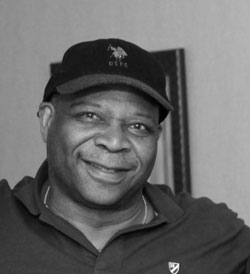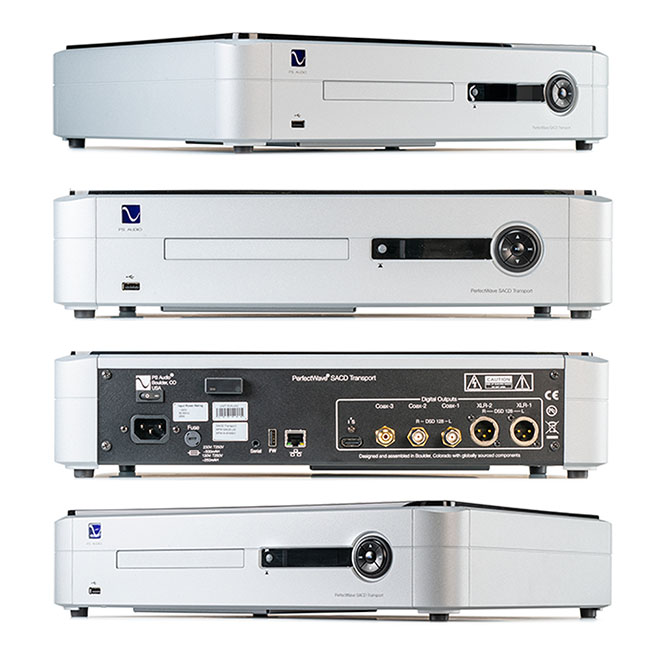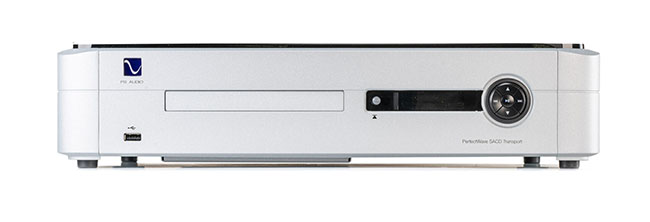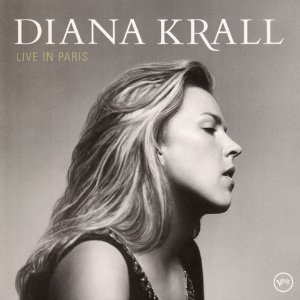PS Audio PerfectWave SACD Transport by Moreno Mitchell

 Introduction
Introduction
I have been a proponent and admirer of PS Audio products for many years. Their commitment to excellence is beyond reproach. PS Audio promotes exceptional engineering and quality throughout the spectrum of its products. No wonder PS Audio is one of the industry’s leaders in digital, analog, and power products. Once I got wind of the new PerfectWave SACD Transport (PST), I reached out for a review sample and was immediately accommodated.
Over the past two years, digital audio streaming has taken the audio world by storm. Compact disc (CD) is becoming less desirable to the audio audience. Let’s face it; there are many advantages to streaming, including convenience and cost. For example, when I speak of convenience, I refer to how easy it is to use streaming components to navigate through a list of recordings without leaving the comfort of the sofa or listening chair. Another example is cost meaning, by subscribing to Tidal or QoBuzz provides a plethora of audio track and music selection options.
 With what I mentioned in the previous paragraph, I am sure the PS Audio designers and engineers considered those points before designing the PWT. However, I can only imagine that PS Audio engineers knew that in competing with the streaming technology, they had to elevate above the technology mentioned above. But, above all, the superior sound quality had to be crucial when engineering the PST. Before getting my hands on the new PST, I resigned to streaming audio-only as my digital source. Years ago, I owned a PS Audio PerfectWave Transport (PWT). I switched to streaming because of convenience. After a while, I missed listening to some of my CDs. I was always curious about Super Audio Compact Disc (SACD) technology; however, when I owned the PerfectWave Transport, it couldn’t accept the SACD format. This lack of compatibility later drove me to inquire about the PS Audio PerfectWave SACD Transport and determine how and if SACD is comparable to Redbook and audio streaming. This review will focus on the PST resolution playback of Redbook discs (16 Bit, 44.1KHz) compared to the native resolution of DSD (2.822MHz), which is 64 times greater sampling rate than a standard Redbook CD.
With what I mentioned in the previous paragraph, I am sure the PS Audio designers and engineers considered those points before designing the PWT. However, I can only imagine that PS Audio engineers knew that in competing with the streaming technology, they had to elevate above the technology mentioned above. But, above all, the superior sound quality had to be crucial when engineering the PST. Before getting my hands on the new PST, I resigned to streaming audio-only as my digital source. Years ago, I owned a PS Audio PerfectWave Transport (PWT). I switched to streaming because of convenience. After a while, I missed listening to some of my CDs. I was always curious about Super Audio Compact Disc (SACD) technology; however, when I owned the PerfectWave Transport, it couldn’t accept the SACD format. This lack of compatibility later drove me to inquire about the PS Audio PerfectWave SACD Transport and determine how and if SACD is comparable to Redbook and audio streaming. This review will focus on the PST resolution playback of Redbook discs (16 Bit, 44.1KHz) compared to the native resolution of DSD (2.822MHz), which is 64 times greater sampling rate than a standard Redbook CD.

Before writing a review on the PS Audio PerfectWave SACD Transport, I did my homework to understand how the unit operated and some of its technical aspects and highlights. (Note: The following bullet points were captured in part from the PST manual.)
The PerfectWave SACD Transport is PS Audio’s most advanced universal disc transport and can play stereo audio from most optical discs, including SACD…..
- Unique Architecture – PS Audio’s digital lens electrically isolates the mechanical transport mechanism from the unit’s digital output stage, thus reducing jitter and timing artifacts.
- Galvanically Isolated Output Stage – This feeds the output of the all-new drive mechanism to the transport’s Digital Lens with a design that eliminates the noise of ground contamination.
- Proprietary Digital Lens Technology – The PST’s latest generation Digital Lens Technology solves timing, noise, and isolation problems.
- Plays the DSD Layer of SACD – The PST can play the DSD layer of SACD when used with a compatible DAC such as the PS Audio DirectSTream series DAC.
These features listed are but a snapshot of the capabilities and specifications of the PS Audio PerfectWave SACD Transport.
Getting started
Upon delivery of the PST by FedEx, I received a shipping box with contents weighing 31 pounds and measuring 20.5″ x 24″ x 10″. The box’s contents included the PST weighing 22 pounds, a pair of white cotton gloves to remove the unit; the piano black top cover had a protective plastic film, one AC plug, the remote control with batteries, and the unit operating manual. PS Audio has to be considered the industry’s leader in attention to detail; the packing of the PST and accessories were housed and shipped double boxed. In addition, the PST was cushioned on a thick plastic insert for shipping protection inside the shipping box.


Initial Setup

Connecting the PST to a PS Audio DirectStream DAC was done with a pair of High Fidelity RCA cables, Hemingway Audio Alpha AC cable, and a Wireworld Platinum Starlight 8 HDMI cable. One note to consider is that PS Audio also states in their manual to use the shortest HDMI cable available for I2S connection.
The PST’s remote control is built to last. If you’re accident-prone and tend to drop your remote often, you will have no worries with this remote. Instead, it is heavily constructed and practically bulletproof. PS Audio designed the remote to work simultaneously with their DAC, Transport, and Preamps. The only problem I encountered with the remote was it must be pointed precisely at the unit for operation. However, the user only needs one remote to control all PS Audio devices.
First Audition
Once connected up, I selected some familiar Redbook CDs. I wanted to listen to the PST right out the box. One of my favorite audio recordings is Herbie Hancock’s “The Joni Letters.” I am very familiar with this recording, and it brings everything (sonically) to the table, especially when listening critically. Upon inserting the Redbook CD into the transport tray, the operation of the tray was quiet and smooth. Out of the box cold, the PS Audio performed admirably. Listening at 44.1 kHz sounded on par with my audio streamer. I was pleasantly surprised that the PS Audio sounded this good out of the box. After listening to a few more Red Book CDs, I set up the PST to run continuously for a few hundred hours using a Purist Audio burn-in CD.
 Second Audition
Second Audition
The PST burned in for approximately ten days before I was ready to listen critically. This second audition was conducted using both SACD and standard Redbook CD formats. I paired the same artists and conducted listening observations by switching from SACD to Redbook. The first artist I listened to was FourPlay, titled “FourPlay.” Listening to both formats provided me with an appreciation and better understanding of both formats. What amazed me was although the preferred format was SACD, the PST held its own while playing the recording at standard Redbook, 44.1KHz as well. I am validating that the PST sounds terrific on the Redbook (44.1KHz) and 28.22MHz.
However, the (DSD) SACD disc was more open and allowed me to hear more of the magic from the FourPlay recording. The Behold BPA768 amplifiers, combined with a pair of YG Acoustics Sonja 2.2i loudspeakers, offered an increased soundstage of space, width, and depth. In addition to improved resolution of low-level details and deep and powerful bass authority, Fourplay (via DSD) provided an absence of noise, allowing the music to take on a more natural and precise presentation. Whatever I played on the PST projected everything truthfully and right, no matter which format was used. Sonically, the SACD discs have more depth and expressiveness to the music when compared to Redbook. However, even Rebook format, when played on the PST, took me up another level in tonality, clarity, and transparency as compared to listening via streaming.
 Third Audition
Third Audition
In the next audition phase, I listened to Redbook, SACD (DSD), Audio Streaming sources, and analog. At this point, the PST had accumulated more than 200 hours. And, I felt it was time to put the PST to more strenuous listening tasks. I listened to Diana Krall’s “Girl in The Other Room” through Redbook, SACD, Audio Streaming, and Album formats. Without boring you with the intricate details, I felt the PST held its own compared to all formats. My ultimate preference is analog (but the dance is changing); the PST got it near-perfect when listening to SACD (DSD) and Redbook. The PS Audio PerfectWave SACD Transport coupled with the PS Audio DirectStream DAC is quite a formidable match. Sonic superiority was evident when comparing audio streaming and SACD (DSD), but I cannot make the same claim comparing analog to digital. When I cued up Duke Ellington’s “Masterpieces” on SACD and played the Mood Indigo track, it presented itself with sonic delight. The horn section exhibited pure energy, adding an aura of joy and excitement to the music; the overall presentation was more refined and precise, displaying a sense of space throughout the sound staging of the recording. However, compared to the sonics of the same track played on an analog turntable, I felt analog offered an ever so slightly increased smooth, natural sonics, with deeper and blacker background details.
Conclusion
Last year before receiving the PS Audio PerfectWave SACD Transport, I felt ready to retire my CD collection. Audio Streaming through Roon and Tidal was giving me all I needed at the time. Since evaluating the PST, I have re-thought retiring my Redbook collection. Most audiophiles want to get every drop of music out of the music source we listen to without leaving anything on the table. Although audio streaming is good, there is nothing like listening to digital music with the PS Audio PerfectWave SACD Transport in the chain. SACD (DSD) is on another level for digital listening. So I squeezed every ounce of music from Redbook and SACD (DSD) by using the PST connected to the PS Audio DirectStream DAC.


Moreno Moreno
Specifications:
PS Audio PerfectWave SACD Transport Price
$6,499
Unit Weight 22 lbs
Unit Dimensions 14” x 17” x 4”
Optical discs: SACD/CD/CD-R/CD-RW/DVD-R*/-RW*/+R*/+RW* (*Audio data file only)
USB Drive: USB Flash Drive with audio files
File formats: MP3/WMA/AAC (~48kHz/320bps)
WAV/FLAC/AIFF (~192kHz/24bit)
ALAC (~96kHz/24bit)
DSD (~5.6MHz)
Outputs: I2S1 I2S output for PCM and DSD (raw)
Coax1 output for PCM and DoP
BNC2 outputs for PCM and DoP; Use in tandem for double-rate DoP
XLR Balanced 2 outputs for PCM and DoP; Use in tandem for double-rate DoP
RJ45 and WIFI:
Ethernet and WIFI for over-the-air code updates
Moreno’s Associated Components
Amplification –
Behold BPA768 stereo amplifiers (2)
Preamp Behold APU768
Behold Phono Stage
Loudspeakers YG Acoustics Sonja 2.2i
REL G1 MKII Subwoofers (4) Stack
Digital Source PS Audio Perfectwave SACD Transport
PS Audio Direct Steam DAC
Streamer Auralic Aries G2.1
Roon Nucleus
Analog Sources Pro-Ject RPM Carbon
Van Den Hul Stratvarious Phono Cartridge
Otari MX5050 BII2 Reel to Reel Tape Deck
Cables Hemingway Sigma Speaker Cables
Stealth Audio Digital Cables
High Fidelity Cable Interconnects
Hemingway AC Cords
AC Conditioner PS Audio P20
Stereo Times Masthead
Publisher/Founder
Clement Perry
Editor
Dave Thomas
Senior Editors
Frank Alles, Mike Girardi, Russell Lichter, Terry London, Moreno Mitchell, Paul Szabady, Bill Wells, Mike Wright, and Stephen Yan,
Current Contributors
David Abramson, Tim Barrall, Dave Allison, Ron Cook, Lewis Dardick, John Hoffman, Dan Secula, Don Shaulis, Greg Simmons, Eric Teh, Greg Voth, Richard Willie, Ed Van Winkle, Rob Dockery, Richard Doron, and Daveed Turek
Site Management Clement Perry
Ad Designer: Martin Perry







Be the first to comment on: PS Audio PerfectWave SACD Transport by Moreno Mitchell